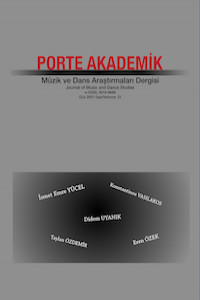Abstract
This paper introduces an instrument recognition approach with the aid of audio loops. The aim is to show a basic instrument recognition recipe for music technology researchers by investigating whether the DAW-based audio loops can be an alternative to researched-based available libraries such as McGill University master samples, UIOWA samples, IRMAS audio libraries. For that purpose, audio loops from Apple Jam Pack were preferred to create instrument classes (Families). The loops were arranged according to their related instrument classes. The class names are Bass, Drums and Percussions, Guitars, Keyboards, Strings, Synthesizers, and Winds. After the extraction of temporal and spectral audio features from those classes, a 5736x105 dimensional dataset emerged. Then this dataset was examined with 19 different supervised machine learning algorithms. The SVM Cubic classification algorithm provided the best accuracy (90.2%). The result shows that the audio loops with mid-term feature extraction can be used for instrument recognition tasks.
Keywords
Instrument Recognition Machine Learning Audio Content Analysis Music Information Retrieval Music Technology Usages of Audio Loops
References
- Agostini, Giulio, Maurizio Longari and Emanuele Pollastri. 2003. “Musical Instrument Timbres Classification with Spectral Features.” Eurasip Journal on Applied Signal Processing, 2003(1): 5-14. Springer Open (Accessed April 4th 2021).
- Albon, Chris. 2018. Machine Learning with Python Cookbook. Sebastopol, CA:O'Reilly Media Inc.
- Alice, Zheng and Amanda Casari. 2018. Feature Engineering for Machine Learning, Principles and Techniques for Data Scientist (1st edn.). USA:O’Reilly Media.
- Bishop, Christopher M. 2006. Machine Learning and Pattern Recognition. In Information Science and Statistics. Verlag, NY: Springer Science+Business Media, LLC.
- De Man, Brecht, Ryan Stables, Joshua D. Reiss. 2020. Intelligent Music Production (1st end.). NY: Routledge.
- Eronen, Antti. 2001. “Comparison of Features for Musical Instrument Recognition.” Proceedings of the 2001 IEEE Workshop on the Applications of Signal Processing to Audio and Acoustics. 2001:19-22. IEEE Xplore (Accessed April 4th 2021).
- Essid, Slim, Gaël Richard, Bertrand David. 2006a. “Musical Instrument Recognition by Pairwise Classification Strategies.” IEEE Transactions on Audio, Speech, and Language Processing, 14(4):1401–1412. IEEE Xplore (Accessed April 5th 2021).
- Essid, Slim, Gaël Richard, Bertrand David. 2006b. “Instrument Recognition in Polyphonic Music Based on Automatic Taxonomies.” IEEE Transactions on Audio, Speech and Language Processing, 14(1):68–80. IEEE Xplore (Accessed April 5th 2021).
- Giannakopoulos, Theodoros. 2015. “pyAudioAnalysis: An Open-Source Python Library for Audio Signal Analysis.” PLOS ONE, 10(12). <https://www.journals.plos.org/> (Accessed April 6th 2021).
- Giannakopoulos, Theodoros and Aggelos Pikrakis. 2014. Introduction to Audio Analysis: A MATLAB Approach (1st edn.). Oxford, UK: Academic Press.
- Han, Yoonchang, Jaehun Kim, and Kyogu Lee. 2017. “Deep Convolutional Neural Networks for Predominant Instrument Recognition in Polyphonic Music.” IEEE/ACM Transactions on Audio Speech and Language Processing, 25(1):208–221. IEEE Xplore (Accessed April 6th 2021).
- Heittola, Toni, Anssi Klapuri and Tuomas Virtanen. 2009. “Musical Instrument Recognition in Polyphonic Audio Using Source-Filter Model for Sound Separation”. Proceedings of the 10th International Society for Music Information Retrieval Conference, ISMIR 2009, 327–332. Kobe:Japan, October 26-30.
- Herrera-Boyer, Perfecto, Geoffroy Peeters and Shlomo Dubnov. 2003. “Automatic Classification Of Musical Instrument Sounds.” Journal of New Music Research, 21(1):3–21. Routledge.
- Herrera, Perfecto, Xavier Serra, Geoffroy Peeters. 1999. “Audio Descriptors and Descriptor Schemes in the Context of MPEG-7.” International Computer Music Conference. Beijin:China, (22-27 October 1999). Michigan Publishing.
- Izenman, Alan Julian. 2008. Modern Multivariate Statistical Techniques: Regression, Classification, and Manifold Learning (1st edn.). NY:Springer.
- Lerch, Alexander. 2012. An Introduction to Audio Content Analysis: Applications in Signal Processing and Music Informatics. NJ: Wiley-IEEE Press.
- Müller, Meinard. 2015. Fundamentals of Music Processing: Audio, Analysis, Algorithms, Applications. Switzerland:Springer.
- Nisbet, Robert, Gary Miner and John Elder. 2018. Handbook of Statistical Analysis and Data Mining Applications (2nd edn.). London,UK:Elsevier.
- Saleh, Hyatt. 2020. The Machine Learning Workshop (2nd edn.). Birmingham,UK:Packt Publishing.
- Schuller, Björn W. 2013. Intelligent Audio Analysis (1st edn.). Berlin, Germany:Springer.
- Tulyakov, Sergey and Venu Govindaraju. 2013. “Matching Score Fusion Methods.” Handbook of Statistics: Machine Learning: Theory and Applications. Vol (31):151–175. ScienceDirect. (Accessed April 8th 2021).
- Yu, Dongyan, Huiping Duan, Jun Fang, Bing Zeng. 2020. “Predominant Instrument Recognition Based on Deep Neural Network with Auxiliary Classification.” IEEE/ACM Transactions on Audio Speech and Language Processing, Vol. 28:852–861, 2020. IEEE Xplore (Accessed April 9th 2021).
Details
| Primary Language | English |
|---|---|
| Subjects | Music |
| Journal Section | Research Articles |
| Authors | |
| Publication Date | December 7, 2021 |
| Submission Date | April 30, 2021 |
| Published in Issue | Year 2021 Issue: 21 |


